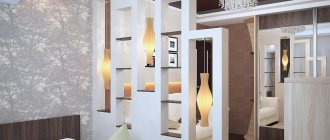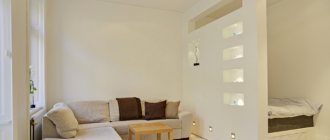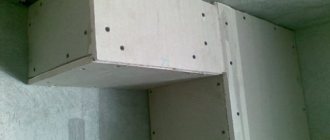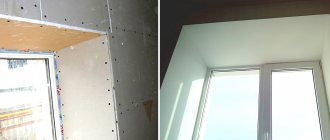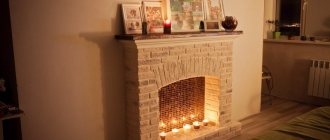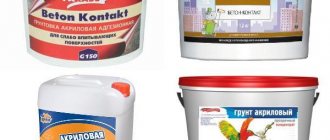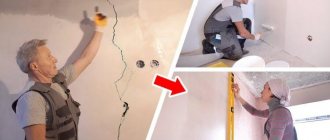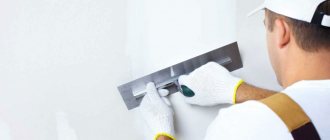The issue of sound insulation in apartment buildings is especially acute. Having a large number of different people living in one building creates noise. Sometimes it reaches high values, exceeding standard values by 2–3 times. What can we say, but even within a single apartment, soundproofing plasterboard partitions is a fairly pressing issue.
The principle of operation of sound insulation of a plasterboard partition
What can make noise?
Finding the optimal solution is not difficult, but first you need to understand why problems arise. We need to answer the question - what conducts sound in a plasterboard partition.
Drywall walls often require sound insulation
- GKL sheathing on the frame is a kind of resonator. There are cavities between the two skins; they constantly reflect acoustic waves. At certain frequencies, the sound is amplified and enters adjacent rooms (any sound equipment works on this principle).
An interesting point - if you simply increase the thickness, the sound insulation of plasterboard walls will not increase. If you look from an acoustics point of view, only the size of the resonator will change. Consequently, when it is increased, the acoustic resonance frequency will shift - towards lower frequencies.
- A certain percentage of vibrations are absorbed by the partition frame, because it is rigidly attached to the main adjacent walls (they are also often attached to ceilings). The solid wall of a building conducts sound perfectly (especially low-frequency) - this happens due to the high density;
- The entire partition at a certain frequency of sound performs the function of a membrane that vibrates in unison with the sound. The frame will transmit acoustic vibrations to capital structures and not only - it also additionally contributes to the propagation of vibrations between the sides of the plasterboard sheathing. All these nuances must be taken into account.
Sound propagation and absorption
The concept of “sound,” as physicists define it, is mechanical vibrations propagated by some source in an elastic medium - air, wood, metal, etc. By emitting vibrations, the source creates pressure (low or high), which spreads in all directions. The sound wave generated in this case enters the human hearing organs and transmits vibrations to the eardrum, the vibration of which is perceived by the brain as sound.
The parameters of sound propagation largely depend on the density of the medium and can vary significantly. So, when encountering an obstacle, sound waves are reflected or refracted. If a porous substance gets in their way, it absorbs the wave, dissipating it inside itself. This physical property of materials is widely used in construction, for example, in soundproofing ceilings and plasterboard partitions.
The greatest dissipation of sound energy is due to an increase in the number of pores and voids present in the substance. The materials themselves, made taking into account these features, are called sound-absorbing or sound-proofing.
Types of Soundproofing Materials
So, having studied a brief theoretical background, we can conclude: effective protection of a home from extraneous sounds is impossible without the use of additional materials. The modern market offers a huge number of solutions to achieve the required level of sound insulation of premises. Materials that are used to combat excessive household noise are divided into two main categories:
- Sound-absorbing (Figure 1). Capable of absorbing sound waves, preventing their reflection and further propagation. They have a granular, fibrous or porous structure and are most suitable for protecting residential premises from extraneous noise, due to easy installation, optimal characteristics and low cost. For example, they are widely used in soundproofing ceilings and plasterboard partitions.
- Soundproofing (Figure 2). They prevent the penetration of sound vibrations by reflecting them. Sound insulators are massive, since it is the thickness and mass that affects their sound permeability. The most common, reliable and high-quality sound insulating materials are concrete, brick and plasterboard.
Let us note that only the joint, combined use of these materials makes it possible to achieve the desired effect when equipping a home with sound insulation.
How to achieve silence
So, everything is clear about the reasons for the phenomenon. Now the problem needs to be solved - you need to figure out what and how to soundproof a plasterboard wall. By the way, plasterboard is also used for cladding ceilings - in this case, sound insulation may also be required. There are a number of effective options here, which will be discussed below.
Achieving silence is quite possible - there are different ways to do this
Damper tape
This is what a damper tape looks like - an invariable assistant in providing sound insulation
Where does soundproofing of plasterboard walls begin? First of all, it is necessary to perform their acoustic decoupling from the main adjacent walls and ceilings. To do this, it is enough to perform one simple action - between the guides (which are attached to these structures), as well as between the structures themselves, lay something, some kind of material that will take on the shock loads.
Foamed polyethylene is perfect for solving the problem - it is usually used. Polyethylene foam tape with an adhesive layer on one side is a product called damper tape. You can buy it at almost any hardware store.
Installation of tape - instructions:
Everything is simple here: the product is glued to the guide profile before its installation. After this, the profiles are secured with dowel screws - it is enough to maintain a step of 50 cm.
What if there is no damper tape in the nearest stores? It's okay - you can always cut it yourself. Foam insulation 4 mm thick is perfect for this (this can be energyflex, penofol, thermofol and more). A polyethylene foam backing under the laminate will also work.
We need to fill out the frame
Is it possible to remove acoustic resonance in wall cavities? Of course, there is nothing complicated here - you just need to add sound-absorbing material to the resonator.
The space between the frame and the wall sheathing must be filled with insulation
Which sound insulator can be installed in a plasterboard wall at the installation stage?
- Simple mineral wool will do. Many insulation manufacturers offer customers special acoustic boards that feature improved sound absorption;
- Mineral wool absorbs noise remarkably well, it’s all about the structure of this material - there are many closed cavities in it, each of which serves as an excellent sound trap.
Useful tips on how and how to soundproof a plasterboard wall with your own hands:
- It is important that the mineral wool fills all the cavities between both sides of the wall sheathing and the frame studs. The slightest gap in the filling forms an acoustic resonator (and that’s exactly what we need to get rid of);
- We should not crush mineral wool when laying it in the frame. The higher the density of the material, the worse the sound-absorbing properties - the sound insulation of plasterboard walls will deteriorate;
- Glued mats are more preferable than rolled insulation. With a size of 1 by 0.6 m, they fit perfectly between the frame posts; no additional fastening is required.
In addition, glued down mats do not slide or cake due to their own gravity. This is good, because if the filler slides, the top of the wall will remain without filling, which will negatively affect sound insulation.
The frame is ready - all that remains is to do the rest, including sound insulation
Choosing the optimal sound-absorbing material
Construction sound-absorbing materials are divided into several groups:
– solid – products made on the basis of porous aggregates (vermiculite, pumice), as well as suspended or granulated mineral wool. They, as a rule, are characterized by high mass - up to 400 kg/m³, average sound absorption coefficient - 0.6;
– semi-rigid – slabs with a cellular or fibrous structure. For the manufacture of such products, various foamed polymers or mineral wool are used. They have a slightly smaller mass compared to solid analogues - up to 140 kg/m³, sound absorption coefficient - 0.8/0.5;
– soft – products with a noticeably expressed fibrous structure, where the fibers are located in a chaotic manner. This group includes: basalt and glass wool, felt, cotton wool. They have the highest noise absorption coefficient - 0.95/0.7, with a relatively small weight - up to 85 kg/m³.
– sprayed – a group of modern finishing products that are widely used in construction to reduce noise levels in rooms. The base of the sprayer is cellulose fibers impregnated with a special adhesive compound. The product is applied to any surface using a sprayer. With this treatment, the thickness of the final sound-absorbing layer can be easily adjusted, if necessary.
apply soundproofing coating
In addition to the noise absorption coefficient, when choosing a material, you should be guided by several other criteria that it must have:
- durability and strength;
- minimal thermal conductivity;
- ease of installation;
- minimal water absorption.
Results
This is approximately how you can get rid of noise when using plasterboard walls. Any owner can organize sound insulation with his own hands if desired - there is nothing complicated about it.
A video on the topic will help you with your work:
Installing plasterboard on walls with sound insulation is a great way to improve the room, while silence will reign in the neighboring rooms. This is very important, because nowadays peace in the room is priceless, especially during rest.
Rating: 4.4 / 5, total ratings: 7
Due to poor sound insulation, people in apartments have to listen to extraneous sounds from the street and neighbors. This is annoying, especially when you want to be in silence after a working day. Soundproofing plasterboard walls is not that difficult, but many extraneous irritants will disappear.
Plasterboard wall finishing
It’s worth saying right away that when installing plasterboard sheets, it is best to use a frame rather than glue, because this method promotes the best thermal insulation by creating an air gap that allows you to retain heat much longer.
Insulating walls from the inside with mineral wool plus is perfect for finishing apartments rather than houses, because for the latter, external finishing will be much more effective, which is quite possible to create yourself, unlike high-rise buildings.
Before starting work, it is necessary to calculate the required amount of material, purchase it, and prepare all the tools.
Which insulation to choose
The choice of insulation directly depends on what degree of insulation needs to be achieved; if the home is located in a fairly warm climate zone, then strong insulation will not be needed, in this case you can use glue for fastening. If the home is located in a cold, harsh climate zone, then the issue of insulation will need to be approached as seriously as possible and choose the best materials, because the comfort and health of the whole family will largely depend on this. Types of insulation:
- polystyrene foam, polystyrene - this is a very light and convenient material that is not difficult to install. It is worth noting that they are susceptible to damage by small rodents, and they do not sound well. To date, it is still not clear how it affects the environment and human health;
- glass wool is a fairly inexpensive material that has low thermal conductivity, but it is very difficult to install, because the fibers can get into exposed areas of the skin or mucous membranes, thereby causing irritation, itching and discomfort, so you must wear safety glasses and clothes;
- Isolon is a material that is considered the most effective because it has an affordable price, excellent sound and heat insulation, and also allows you to save space in the room due to its small thickness;
- Basalt wool is a material produced from rocks; it is comfortable to work with, retains heat well, and has increased fire resistance. This is a great option for people with allergies because it is completely hypoallergenic.
It is worth noting that when making repairs, it is better to use insulation that is made in the form of sheets; they are especially suitable for independent work (their standard width is 60 cm, it is optimal for installation between frame posts).
Materials in the form of rolls must first be measured and cut; this takes more time and effort, so professional teams of several people prefer to work with them.
Installation of insulation
It must be said right away that if the walls are damaged by mold, it is imperative to get rid of it. To do this, you need to dry the walls using a hair dryer, after which you will need to scrape off all the mold with a suitable tool, after which you will definitely need to treat all surfaces with a special fungicide.
Is additional sound insulation needed for a plasterboard wall?
Drywall is a partial sound absorber. If there are strong sounds outside the apartment:
- roadway – busy traffic;
- landing;
- lift shaft;
- rowdy neighbors;
- entertainment centers or other clubs.
Then sheets alone will not be enough. Before installing the gypsum board into the frame, it is necessary to lay soundproofing material and also apply tape. This will enhance sound absorption.
In some cases, vibration suspensions are used to reduce vibration, which also leads to noise.
How to make sound insulation with your own hands
In order to soundproof a wall, it is necessary to allocate 10-12 cm of space around the perimeter of the room. They will go towards erecting a metal frame and laying the material.
To achieve maximum results, in addition to sealing material, acoustic plasterboard sheets are used. They are the best sound absorbers and help achieve silence in the room.
Choosing material for an apartment
For sound insulation, you can use ordinary materials. However, the installation technique should not be violated. If you do not use a damper tape during the construction of the frame, all the work will be in vain.
There is also KNAUF acoustic plasterboard to absorb sounds. If not, use regular plasterboard, sometimes in 2 layers. Materials such as polystyrene foam, penoplex, polyurethane foam reduce noise penetration by only a few percent. They are designed for insulation.
Glass wool has good performance. It can make a room quieter. However, if you do not use a damper tape, the performance will be reduced.
Under the double layer of plasterboard, three layers of sound insulation material “Soundline-DB” and a sound-absorbing board “Shumanet - ECO” are used.
If the drywall is already installed and there is finishing, then a wall membrane is used on top.
Choosing a soundproofing method
There are several methods for soundproofing a room.
- Laying insulating material into a metal frame for drywall. For this purpose, mineral wool is used.
- Application of acoustic plasterboard. Sometimes this is done in 2 layers.
- Application of soundproofing membrane.
Materials used to fill partitions
Effective sound protection for a plasterboard partition can be made using various options, which will vary according to the materials used. The following can be used as soundproofing materials:
- acoustic or soundproofing plasterboard;
- cotton filler;
- sound-absorbing membrane;
- soundproofing foam.
Sound insulation using acoustic plasterboard is distinguished by its simplicity. Acoustic sheets are installed on the manufactured frame, and the finishing layer is made using conventional gypsum fiber board.
An equally popular method is the soundproofing of plasterboard partitions using cotton fillers. Thanks to the soft and porous structure of the material, good results and effective protection can be achieved. To use such a material, it is necessary to make a profile structure that will hold the material and create the desired effect. There are a lot of varieties of cotton wool, so it is possible to choose the most suitable option in terms of cost and characteristics.
Photo: The process of creating a partition. Author: Konstantin Kostolomov
If it is necessary to create silence, and the thickness of the partition is quite thin, then noise-absorbing membranes can be used as an insulating material. Such a filler will be able to retain sounds, and due to its thinness, it can be installed in very thin interior partitions.
Some craftsmen use special foam as insulation, which, thanks to its porous base, absorbs sounds well. Foam is applied using appropriate equipment. In this option, it is important to adhere to technology and safety conditions. Foam sound insulation must be carried out by specialists.
Important! To achieve maximum sound insulation efficiency, you need to use high-quality materials that meet the requirements and characteristics of the intended product.
Do-it-yourself noise insulation
In order to make soundproofing, you need to prepare. Initially, you need to determine what type of material to use for sound insulation. It depends on the room - temperature changes, humidity.
After this, prepare the surface. All cracks and crevices must initially be widened and then plastered using reinforcing tape. After this, the surface is cleaned of dust and primed.
The next step is marking the surface. This is done using plumb lines and levels. Upholstery cord is also used.
Materials
To carry out soundproofing under plasterboard on the walls, you will need the following materials:
- damper tape - it is glued to guide profiles, fixed with self-tapping screws to the wall, floor, ceiling;
- vibration suspensions for rack profiles - dampen vibration and sounds coming from outside;
- for sound insulation, you can choose mineral wool - the best option;
- You also need to use a membrane film.
Tools
To install a plasterboard surface on a frame base with sound insulation, you will need the following tools:
- construction knife with a set of blades;
- ruler, pencil, level, meter;
- plane;
- spatulas with different blade sizes;
- screwdriver, drill;
- metal scissors;
- hammer.
Progress
The damper tape must be glued to the guide profiles and hangers. After using dowels and nails, fix the metal strips along the marks. At a distance of 40 cm from each other, hangers are attached along the notched lines for the rack profile. Rack profiles are fixed onto them by inserting them into the guides. To create a rigid structure, metal strips cut from the racks are horizontally attached between the racks. Crabs are used to connect the planks.
Next, after creating the metal structure, mineral wool must be laid. To ensure dryness and greater sound insulation, a film is fixed under the cotton wool.
After laying the soundproofing material, you need to run the cables and make the electrical wiring. All electrical wires are hidden in corrugation.
After the work is done, plasterboard sheets are installed.
Decorative finishing
An important condition for the long service life of a plasterboard structure is sealing the joints. For this, putty and KNAUF tape are used.
After the putty has dried, the surface is primed, puttyed with a finishing solution, rubbed and covered with putty again. All subsequent finishing is decorative:
- Painting with water-based paint, water-resistant.
- Finishing the painted surface with molding.
- Wallpapering, liquid wallpaper.
- Decorative plaster.
- Finishing with slabs and ceramic tiles.
Each type of work has certain conditions and its own technology.
Technology for installing insulators under drywall
As a result of preliminary preparation of the walls, clean, dry surfaces should be formed, free from any unevenness in the form of holes, cracks and fungal infection. Pockets of mold are cleaned and treated with an antiseptic, and the defects are carefully puttied.
To assemble the sheathing, wooden slats or metal profiles can be used. The former are attractive due to their high thermal insulation properties, but they need to be protected from drying out; the latter are not subject to deformation, but are vulnerable to corrosion.
The blanks are fixed with flat cutters at the boundaries of the wall, then vertical slats are mounted in increments of 60 cm (the insulation must fit tightly into the resulting grooves).
The method of fixing the material depends on its essence. Foam boards are installed using special dowels and glue, the joints are additionally reinforced with construction tape, and the cracks in the area where they meet horizontal surfaces must be filled with silicone sealant. To fix the mineral wool, you will need foam glue: it is distributed around the perimeter of the slab and applied a little in the center.
The vapor barrier layer can be formed from dense polyethylene film or construction foil. Next, they begin covering the cake with plasterboard using self-tapping screws. The cracks are filled with putty, cleaned to prevent cracking of the putty, and the top is covered with paint or special tape. If the base was laid with a metal profile lathing, in order to prevent the occurrence of cold bridges, tapes from the main heat insulator must be placed in its cavity.
The service life of the solution considered is determined by the type of insulation used. On average, it varies between 20-30 years. As the material ages, it loses a third of its beneficial properties due to caking and drying out, so it should be promptly replaced with a new one.
Life time
A plasterboard structure, created according to all the rules, taking into account external factors - humidity, temperature, lasts 50 years. Mineral wool, unfortunately, has a service life of 10 years. But, to replace the soundproofing material, the gypsum board can be carefully dismantled.
When choosing a soundproofing material, you need to pay attention not only to decibel damping, but also to environmental friendliness, moisture resistance, and shelf life. In addition to sound insulation, furniture installed near a plasterboard wall serves as an addition. Wardrobes, dressing table, installed decorative fireplace. Created niche for TV.
Review of sound insulation methods and characteristics of materials
There are two ways to insulate the ceiling:
- Place insulation in the space between the profiles;
- Use GCP - gypsum combined panels.
A gypsum combined panel is a building structure consisting of two layers, one of which is a sheet of plasterboard, and the second is an expanded polystyrene board securely glued to it. The panel is used not only in interior but also in exterior decoration. It is glued with heavy-duty glue to the surface to be treated, which must be perfectly flat. The length of the gypsum boards is from 30 cm to 2.5 m, the width is 60 cm and 120 cm. Working conditions – temperature not lower than +5 degrees, normal humidity conditions.
Mineral wool
Acoustic boards are successfully used to provide good sound and heat insulation properties. Manufactured with or without the addition of synthetic binders. In mineral wool with a synthetic binder, at a temperature of 300 degrees, harmful components are released into the surrounding space. It is hazardous to your health to be nearby when the material catches fire.
From an environmental safety point of view, it is better to use slabs that use an inert polymer to bind the fibers
It is important to choose acoustic mineral wool based on the basalt component. Many domestic and foreign companies are involved in its production.
The most famous are Acoustic Group, Knauf, Rockwool, TechnoNikol. Mineral boards with longer and thinner fibers are better.
Mineral wool is often used to soundproof plasterboard partitions.
Soundproofing membranes
Membranes provide a certain degree of noise absorption. They are used as a complement to mineral wool or separately. They are glued to the floor slabs and covered with plasterboard on top. Some membranes have a self-adhesive surface, so their installation speed is as high as possible. The thickness of the mats is 4-20 mm, the cost is 800-1000 rubles per m2.
The noise level is reduced by 20-60 decibels, according to manufacturers, which is most likely a marketing ploy, since the maximum noise reduction value that multilayer structures can provide is 15-20 dc. Well-known names of membranes are “Zvukoizol”, “Teploizol”, “Shumanet”, “Texound”.
The permissible noise level during the daytime should not exceed 45 dts. For a person, a comfortable value is 20-25 dc, which can be achieved by using acoustic mineral wool. The best option is to glue the membrane to the base and then fill the space with basalt slabs.
Vibration suspensions as a way to improve sound insulation
Elastomer-based fasteners are a good way to completely isolate the ceiling structure from the load-bearing foundations.
Each suspension has a rubber gasket with which it comes into contact with the ceiling. Its fixation is carried out in the same way as usual - with an anchor dowel-nail.
What can make noise?
During construction, sound insulation is not always created for plasterboard walls. Some masters are confident that if the partitions are of high thickness, then no additional procedures are required. There are always cavities in the wall that reflect sounds; they fall into adjacent rooms. Even if the wall thickness is increased without additional sealing, there will be no soundproofing protection. Noise appears due to vibrations of internal floors and vibrations of partitions.
Load-bearing structures in the room conduct sound well due to rigid fastenings, especially if this sound is low-frequency. The partition acts as a membrane, transmits sound vibrations, and promotes their propagation. GCR is able to block these vibrations. They will remain inside the ceilings and subside.
Benefits of drywall
Drywall, unlike brick or foam block, does not limit the imagination of designers in any way, and anyone who knows how to hold the simplest tools in their hands can handle the installation of a plasterboard partition. Plasterboard partitions are lightweight, so they do not create a noticeable load on the floors and the building structure itself.
Drywall sheets themselves have excellent sound and heat insulating properties, and the empty space between them further enhances this effect. Therefore, if you line the walls facing the street with plasterboard, this will not only prevent the cold from entering the room in winter, but will also prevent the heat from the walls heated by the scorching sun from penetrating inside. In this case, it is advisable to mount the sheets on a metal frame, not directly on the wall. The space between the drywall and the wall provides additional insulation.
How to achieve silence
A soundproof wall will provide peace and quiet. If it is made of plasterboard, then the level of protection can be increased using damper or polyethylene foam tape, as well as filler. The combination of two elements at once will create an acoustic decoupling from the capital adjacent walls and ceilings.
The tape is placed between the guides and takes on the shock loads.
What is required for sound insulation
To choose a filler, it is worth considering all the options that the construction market can offer:
Acoustic drywall pros and cons
Acoustic plasterboard is a new material on the construction market. It has a lot of positive qualities, including excellent sound retention. But there is one very important nuance - it is not suitable for complex finishing, i.e. it cannot be wallpapered, puttied, or plastered. Acoustic plasterboard can only be painted, and you will agree that this is not always the best option, especially in relation to interior partitions, since it is not a fact that the painted perforated wall surface will fit well with the existing interior. As an alternative to the external installation of acoustic gypsum boards, builders suggest installing them in the internal space of the frame with the additional installation of mineral wool.
We use soundproofing plasterboard
Strengthening sound insulation on a finished wall
If a wall made of plasterboard with sound insulation still allows extraneous sounds to pass through, then you can enhance the protection with the help of finishing materials. For this purpose, there are special wallpapers with a cork seal on the inside. This layer will enhance the sound insulation of the walls. The option is considered optimal, because other procedures will have to be carried out on top of the existing surface. Additional sound insulation is also created by special thin slabs made of cork or membrane. To fix them to the wall, special glue is used.
Some manufacturers provide an adhesive complete with the slabs.
Preparing tools and collecting materials
The preliminary stage of work is drawing up a basic plan for the future wall. You can model it on a computer or simply draw it with a pencil on a piece of paper. Its creation makes it possible to get a complete picture of the scope of future work and visualize the object.
Installation of a plasterboard structure with soundproofing material on a brick wall
The finished plan must contain the aspect ratios, their geometric dimensions and angles. The only condition that is put forward for the project is maximum detail. It is this that is the key to success and allows you to significantly simplify the process of installing the partition.
A suitable plan for partitions and walls made of plasterboard, showing the location of profiles for installing a gypsum plasterboard structure
Obtaining a visual representation of the structure marks the beginning of construction work. However, their implementation will be impossible without preparing a tool for working with plasterboard, the list of which is as follows:
- pencil;
- level;
- plumb line;
- knife;
- spatulas of different sizes (narrow and wide);
- screwdriver;
- solution container;
- grout mesh.
Each of these tools must be prepared for work and stored in a specific place. At the same time, in order to understand the full structure of the process and assess the scale of construction, it is necessary to purchase a whole set of components for drywall, the list of which is as follows:
- rack profile-CD and guide-UD;
- three types of screws for the profile (25 mm, flea and 45 mm) and screws for fastening drywall;
- mineral wool;
- perforated plasterboard (acoustic);
- soundproofing membrane;
- reinforcing tape;
- gypsum putty.
As you can see, the list of necessary materials is quite extensive. However, each component in it is necessary and performs its specific function.
Watch the video: installation of a partition with sound insulation.
How to calculate the thickness of a partition for walls
To calculate the size and thickness of the partition, use the formula. It is important to consider the size of the sheets, frame and filler. Standard indicators:
- partition width – 10 cm;
- plasterboard – 12.5 mm;
- metal profile profile – 9.5 mm;
- steel – size 50.
These parameters can withstand a load of 50 kg. If the insulation/filler is heavier, the performance increases. For weights from 70 kg, the size of drywall is from 18 mm, and metal slats are from 12.5 mm.
Formula for calculating thickness: metal lath size (9.5) * plasterboard sheet size (12.5): 2 = 59.4 cm.
Permissible loads on the partition
Noise insulation of a plasterboard partition should be carried out taking into account the permissible loads on the structure. The table shows the standards.
| Thickness of plasterboard sheet/mm | Permissible load if plastic dowels are used/kg | Permissible load if metal dowels are used/kg |
| 10 | 20 | 40 |
| 12,5 | 25 | 50 |
| 2x10 | 35 | 60 |
| 2x12.5 | 40 | 70 |
The load is calculated before installation work begins.
Permissible loads on the partition
Photo: Permissible loads.
Author: Konstantin Kostolomov When making an interior partition, it is important to correctly calculate the thickness and load that will be on the frame. Everyone wants to make a partition in such a way that it does not take up much space. When forming a structure, everything is selected depending on the profile parameters.
Photo: Permissible loads. Author: Konstantin Kostolomov
The most suitable size is considered to be a partition thickness of at least 12.5 centimeters. During installation of the partition, the load to which the structure is subjected must also be taken into account. With a load of 40-50 kilograms per square meter, the sheet thickness should be no more than 16 mm. If the weight per square meter is 70 kilograms or more, then it is recommended to use additional frame posts. The thickness of the structure will be greater, but it will remain reliable and durable.
Important Features
Sheathing increases sound insulation, but this figure can be increased if you add mortgages to the partition, use plywood instead of gypsum fiber board, or build a structure from double profiles. Some craftsmen suggest laying double sheets of drywall, but if you consider it from the point of view of financial benefits, it is better to immediately purchase a sheet of the required thickness.
Use of wooden mortgages
A plaster construction will be much stronger if you use wood embedded parts inside the structure. They are added to the profile and ensure the stability of the partition. With the help of mortgages, you can double the strength of the load-bearing elements of the product.
Using dual profiles
This method is called "overlap". Plaster construction is sometimes reinforced with a double profile. It is installed next to each other and secured with self-tapping screws. Thanks to this connection technology, the strength of the partition is doubled.
Assembling the supporting frame
The installation of the frame for plasterboard cladding is carried out according to an identical scheme, regardless of the design features of the partition. The sequence of steps to install it is as follows:
- Using a level and plumb line, the initial profile is set. All subsequent racks will be guided by it. Therefore, it should be installed as evenly as possible in relation to all planes.
- A UW profile is attached to the floor and ceiling, which is necessary to ensure structural rigidity. It is fixed using drywall screws, which are screwed in every 40-50 cm.
- The guide profile is filled with vertical posts, which are installed every 30 cm or 60 cm. They are fixed using metal screws or a special cutter.
- To increase the load-bearing capacity, vertical rack-mount CD profiles are fastened with horizontal guides. They provide the frame with greater rigidity and immobility.
The process of installing a sheathing frame under plasterboard does not contain secrets and is carried out with your own hands in the shortest possible time. At the same time, the strength and appearance of the future partition will largely depend on the quality of installation work.
